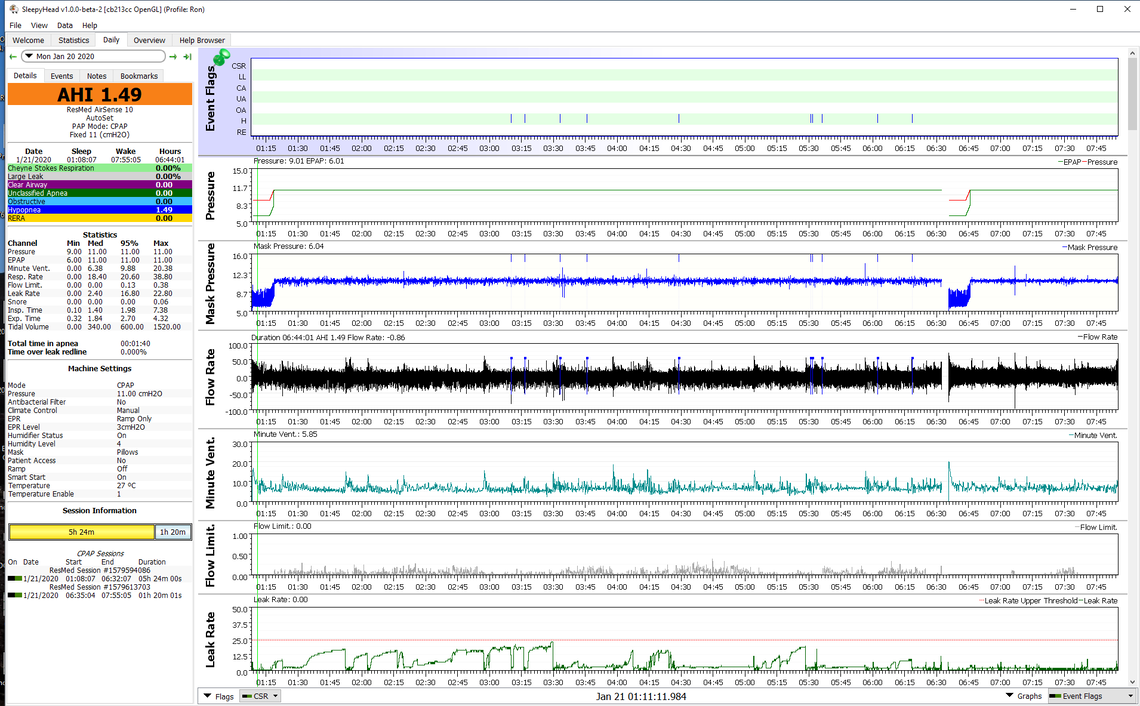Hi I'm new to this forum and my detailed data says I have central apneas. Does anyone know how the cpap determines or distinguishes a central apnea from an obstructive apnea? My doctor says the machine cannot determine the difference! I have looked for a technical manual for the airsense 10, but cannot find one. Does anyone know how to find the technical manual?
Here is a link to a manual. It explains how it works. Essentially the machine pulses the flow at a high frequency and checks to see if the pressure goes up when the flow goes up. If it does, it concludes the event is a an obstructive apnea. If the pressure does not change significantly, it concludes the airway is clear. The CPAP manufacturers call them clear airway events, probably for legal purposes, but for all practical purposes they are central apnea events.
Hello Sierra, and thank you! My sleep doctor, a pulmonologist, could not explain how the airsense 10 determined the central event, and insisted the only correct method of determination was with a sleep study, via a belt around my midriff. It makes a lot of sense that the machine is designed to make this determination via the method you described! Thanks again for your help, and for all your previous comments, which I shall read.
Here is another document you may find of interest:
ResMed Innovation and Technology
The advantage of detecting central and obstructive apnea with a sleep test is that it is done without supplying any pressure. CPAP machines maintain a minimum pressure of 4 cm of water, and in most treatment cases much higher than that. So that pressure can reduce the frequency of obstructive apnea, and may even increase the frequency of central apnea. So if you want to know the degree of apnea without any treatment pressure, then the CPAP cannot do it, like a sleep test can. However if you are under CPAP treatment and just want to measure how well controlled central and obstructive apnea is, the machine can certainly do it.
Oh, and one other point, is that not all machines can distinguish between obstructive apnea and central apnea. Unless they have improved recently the Fisher and Paykel machines cannot tell the difference. For that reason they should never be used with someone who is experiencing central apnea. If the machine does not know enough to tell the difference and increases pressure in response to a central apnea, it could make it worse, not better. DreamStation and ResMed machines however can both tell the difference.
Hi SleepInnovater, You rock! Thanks again! I'm glad I have the Res Med device.However, this new device did not come with an SD card. My old ResMed Airsense 10 did have a card, but if I put it into the new machine, which I purchased early in 2019, I will lose all the data from it, but the data should still be in the My Air records. The old cpap did not report such high leaks as the new one does. Do you think there is any reason not to format the old card and put it into my new Airsense10?
So, first, which AirSense model do you have? The very basic AirSense 10 CPAP does not record any detailed data. The AirSense 10 Elite does record, as does the AutoSet model.
Assuming both machines were/are capable of recording detailed data, I would first download OSCAR software, and then transfer the data from your old machine into OSCAR. You will need a PC or Mac and a SD card reader. Once you have transferred your old data to OSCAR it will be saved. Then you can format the SD card, or just delete all the files, and put it into your new machine. When you transfer the data from the new machine it will be added to your existing records, and the starting point of the new machine will be indicated. It will be shown as a new machine with a new serial number.
The SD card will have much more detailed data than you have in MyAir. That is just high level summary data. If you follow this process it should be easy to determine what may have changed between the old machine and the new. For example you will see in detail second to second how much your mask is leaking and to what degree. See my daily report from last night. The bottom graph is the leak rate during the night. The red line shows the 24 limit, and I try to keep my time over the leak red line close to zero. This is a compressed graph which can be greatly expanded to the point where you can see each apnea even in second to second detail, and see the machine testing for the type of apnea it is.
